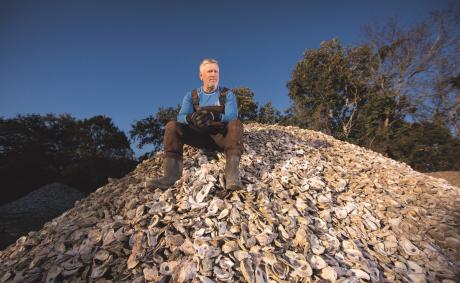In a world dragging its heels in facing the existential crisis of climate change, Drew Shindell is leading the way toward consensus. It starts with cow burps.
Shindell, the Nicholas Distinguished Professor of Earth Science at the Nicholas School of the Environment, has turned the attention of scientists and environmentalists toward methane – the gas escaping from rotting garbage, swamps and cow burps. It may sound silly, but livestock produce around 14 percent of annual greenhouse gases, much of it methane. Unlike CO2, which is easily measured, methane was hard to track until recent improvements in infrared and satellite cameras that can detect it.
Carbon dioxide remains the main climate culprit, and the greatest long-term problem. But methane traps much more heat in the atmosphere in the short term: “Over a century it’s about 30 times worse,” Shindell says. “Over 20 years, it’s nearly 100 times worse, which means methane cuts can really give you a reduction in climate damages within the next couple decades, whereas decarbonization is slow and will take much longer to get benefits. So they are really complementary. You want to do both.”
Under the aegis of the U.N. Environment Programme’s Climate and Clean Air Coalition, Shindell chaired the worldwide Global Methane Assessment, an effort to determine the environmental impact of methane emissions. In 2021 it reported that methane should be considered much more central to the fight against climate change. Methane is not just a win-win but a strategy whose wins keep multiplying. “There were so many attractive things about it,” Shindell says of limiting methane. Methane traps heat like other greenhouse gasses but also produces ground-level ozone, which harms people, plants and wildlife. Thus, decreasing methane “would mitigate climate change, it would improve public health, it would be good for agriculture, it was financially appealing because a lot of the [ameliorative steps] were low-cost.”
The world has quickly agreed. Shindell notes the Inflation Reduction Act of 2022 imposes a charge for methane emissions, a goal environmentalists have unsuccessfully pursued for decades regarding CO2. And more than 125 countries, responsible for more than half of annual methane emissions, have already subscribed to the international Global Methane Pledge (the goal of a 30 percent reduction in emissions by the end of this decade). This could eliminate 0.2 degrees C of warming by 2050.
Climate work like Shindell’s is far from alone at Duke. All over campus, researchers wrestle with the complexity of the climate crisis. Interdisciplinary programs encourage collaboration between researchers and clinicians. Electric buses now patrol the campus, with the university pledging to continue working its way towards carbon neutrality by 2024. All are part of the Duke Climate Commitment, announced by President Vincent Price in September 2022.
Shindell points to the synergy created by the Data Expeditions: Climate + Health program, which combines resources from engineering and environmental researchers and the School of Medicine to use data to explore the impact of climate on human health. “I think that’s one of the ways that people really respond,” he says, “is understanding that either their health or the health of their loved ones is affected by this.”
Some students, faculty, and staff want more. The student-led advocacy group Duke Climate Coalition has demanded the university divest its endowment from fossil fuel companies, and its leaders express frustration that divestment wasn’t part of the Climate Commitment.
Professor of law Gina-Gail Fletcher, chair of Duke’s Advisory Committee on Investment Responsibility, says divestment would have little real effect. It’s still a fossil-fuels world, she says, and “divestment isn’t the only way to accomplish some of the goals the students seek to accomplish.”
Duke, she says, has no direct investments in the Carbon Underground 200, the largest owners of coal and oil and gas reserves. Moreover, she says, “Though the Climate Commitment has aspects
that are undertaken less to weaken fuel companies than to demonstrate leadership in climate response, those aspects are symbolic with a positive impact,” marking hundreds of millions of dollars committed to research and to campus carbon neutrality. A student, faculty and staff advisory committee evaluates potential carbon offsets to make sure they square with the university’s climate goals.
Researchers, administrators and students all address the complexity of the coming years. There is a lot more to climate change than cow burps and even the strongest university commitment to carbon neutrality – and it’s time to get busy.
“Even the people that care a lot about climate, typically think it’s something that the effects happen to other people and happen in the future,” Shindell says. The methane progress may indicate “a growing awareness – with fires and hurricanes and droughts and floods and such – that some of it’s happening now.”




